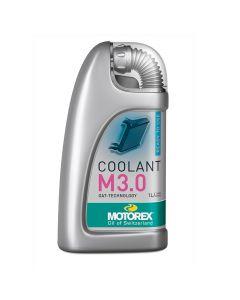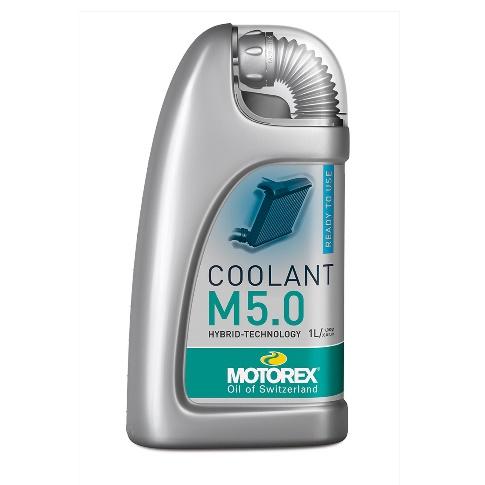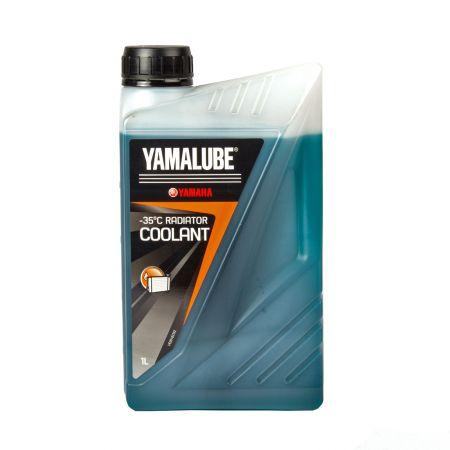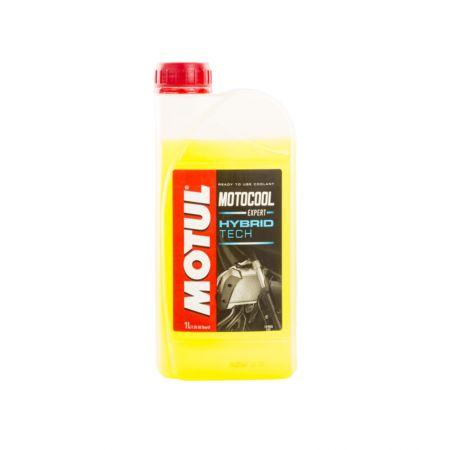Motorcycle Coolant: The Need-To-Knows
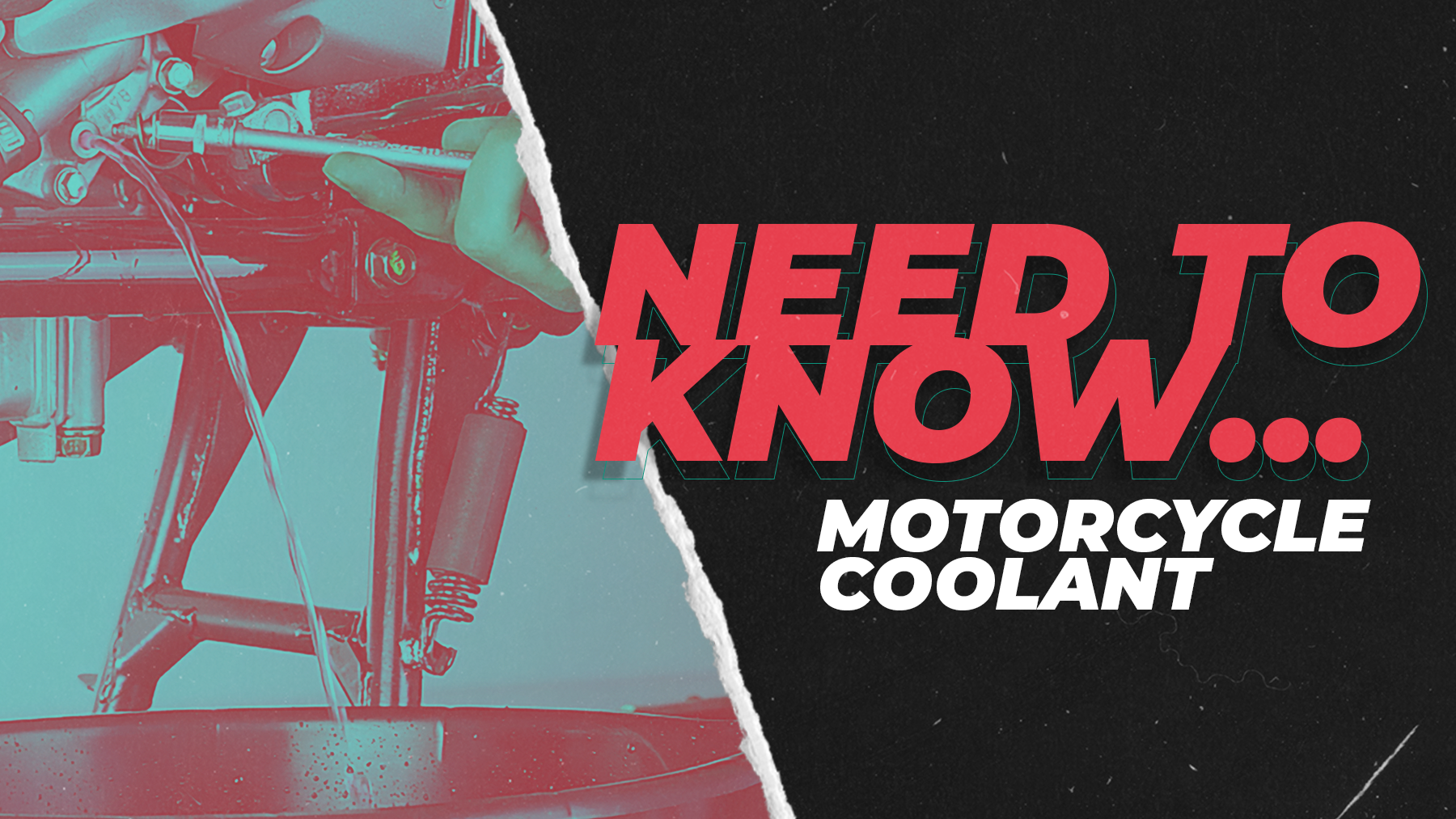
What is motorcycle coolant and why does your bike need it? We go through everything you need to know about this vital motorcycle fluid and how to choose a coolant for your ride.
Air-cooled engines used to be the norm on bikes in days gone by and generally worked very well, as the engine was exposed and was, therefore, cooled as you rode. Cooling fins around the cylinder head and block helped to disperse the heat and give exposure to the air over a large surface area.
But maintaining an even running temperature is ideal, and all the time we have climates, seasons and traffic congestion, along with the increased use of fairings and other bodywork, an air-cooled engine will never do that as well as a liquid-cooled one. In the strive to improve things, liquid-cooled engines have now become the norm.
The coolant circulating a liquid-cooled engine is vitally important, not only for maintaining an even running temperature in a range of environments, but also for preventing the water in it from freezing or boiling in extreme situations of use, and for keeping the internals of the cooling system corrosion-free.
Motorcycle manufacturers specify the type of coolant, and often the brand, that you should use, and the details will be in your handbook or can be obtained from a dealer. A particular type is specified for a reason, as we explain here, and you should stick to it.
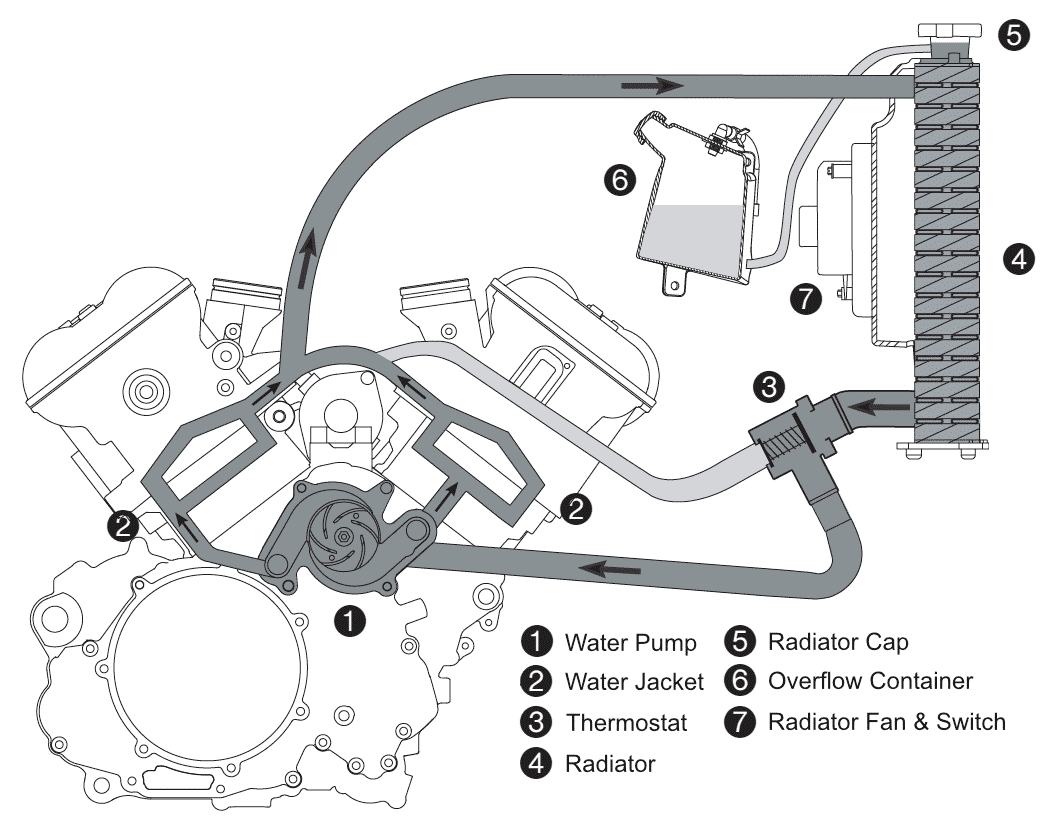
Cooling system layout on a modern V-Twin
What is the difference between coolant and antifreeze? What’s wrong with using water?
A coolant is, by definition, anything that cools something, and so plain water can be a coolant. Antifreeze is by definition something that prevents something else from freezing.
The use of different terminologies such as coolant and antifreeze to describe the same product can confuse. Coolant has become the generic term used in the automotive industry for products that contain both antifreeze and water.
The main reason for using a specified coolant rather than just water is that it contains antifreeze and corrosion inhibitors. Apart from doing the obvious of preventing the water content in a coolant mix from freezing, which will cause serious damage as the water expands when frozen, antifreeze also raises the boiling point of the mixture to above 100ºC to prevent it boiling.
Tap water, and particularly hard water, contains minerals that will corrode and clog the coolant passages quite quickly, hence the need for corrosion inhibitors. This is why it is important to use the correct coolant mixture all year round, and to not let the mix become diluted by topping up with just water.
A guide to modern coolants
In the early days of liquid-cooled motorcycle engines, choosing which coolant to use was easy because they were all pretty much the same and all you had to decide was which brand you wanted and whether you bought it in concentrate or ready-mixed form.
Nowadays, however, in the pursuit of optimum performance, things have predictably got a lot more complicated. Not all coolants are the same.
The majority of coolants use glycol to lower the freezing point and raise the boiling point. Most use ethylene glycol, but some use the less toxic propylene glycol. This is diluted 50/50 with water, usually deionised, and to this is added other chemicals to prevent corrosion and cavitation and various other unwanted things from happening. It is the type of corrosion inhibitors that are added that determine how the coolant is classified.
There are now three main types of coolant, namely IAT (inorganic additive technology), OAT (organic acid technology), and HOAT (hybrid organic acid technology).
Thankfully, there isn’t a HIAT coolant, that would just be a step too far (or a typo). However, HOAT coolant may also be called P-HOAT if it contains phosphates or SI-HOAT if it contains silicates. And you can also buy it in concentrate or ready-mixed form.
IAT, OAT, HOAT – what is the difference?
IAT coolant is used in older engines and has mainly inorganic silicates and/or phosphates (depending on where it was made) but may also use nitrates, nitrites, molybdates and borates, as corrosion inhibitors.
It can be used in all mixed metal engines and radiators, including those with steel, cast iron, aluminium, copper, brass and solder. The anti-corrosion properties deplete over time and IAT coolant should be changed every two years or as specified by a bike’s manufacturer.
OAT coolant is used in modern engines and has organic acids as corrosion inhibitors. It can be used in engines and radiators containing steel, cast iron and aluminium, but not copper and brass. OAT coolant lasts longer than IAT, even though its anti-corrosive properties are not as good, but still needs to be changed as specified by the manufacturer.
HOAT uses either silicates (Si-HOAT) or phosphates (P-HOAT) and organic acids. It can be used in engines and radiators containing steel, cast iron aluminium, and aluminium and copper alloys. HOAT coolant lasts longer than IAT coolant, and some types now last longer than OAT coolant, but it still needs to be changed as specified by the manufacturer.
Green, blue, pink, yellow, orange – what is the difference?
Coolants are now colour-coded, and while on the face of it this seems like a grand idea, in that you would think that the colour-coding would apply across the industry as a standard, with one colour for IAT, another for OAT and a third for HOAT, that would be far too simple!
In practice, each manufacturer has its own colour-coding system for its coolants, so one man’s IAT is blue and another man’s OAT is….blue. So you can’t just look in your reservoir to determine which one to buy based on its colour. Typical.
Don't judge a coolant by its colour
What coolant should I use?
The golden rule is to only use the type and make/brand of coolant that the manufacturer of your bike specifies, and you mustn't mix the different types
In fact, you shouldn’t even mix different makes of IAT coolant with each other, and the same goes for different OAT and HOAT coolants, as manufacturers use a variety of extra chemicals, for example, to reduce cavitation or increase longevity, to achieve the same results, and the chemicals in one OAT coolant may not be compatible with those in another OAT coolant.
In cases of emergency, and for short-term use only, you can top up a system using just water as long as the ambient temperature is guaranteed to remain above zero, and this is better than having too little or none of the recommended coolant. But if you use anything that is not exactly as specified by the manufacturer you should drain, flush and refill with the correct coolant as soon as possible.
Coolant loses its effectiveness as a corrosion inhibitor over time, even if the bike is not being used much, and so it must be changed at each service interval specified by the manufacturer. It is also essential that you check the coolant level in the reservoir frequently, even when the bike is new and the mileage is low – refer to your handbook or manual for details on how to do this safely.
Should I use a concentrate or a ready-mixed coolant?
That is entirely up to you, but the danger in using a concentrate and adding water is that you might use the wrong type of water. Yes, things get complicated again – there is deionised water, distilled water, soft water and hard water. So the safest thing to do is to buy the exact type and brand of pre-mixed coolant that your manufacturer specifies.
If I do use a concentrate, which type of water should I mix with it?
Now there’s a question, the answer to which will depend on who you ask. There is a lot of contradictory, misleading and incorrect information out there, so if you are going to Google the question, prepared to become confused and not find a definitive answer.
Our advice, as given before and I am sure it will be given again, is to stick to the pre-mix coolant that is recommended by the manufacturer of your motorcycle, then you can’t go wrong and don’t have to go through the painful process of making a decision. If you do already have some concentrate that you want to use up then I would use as first choice deionised water, second choice distilled water. As long as you change the coolant regularly as specified by the manufacturer, then the effects of the differences between deionised and distilled shouldn’t come into play. Do not use tap water, in particular hard water, unless it is in an emergency, and if you do you must drain and flush the system asap and refill with the correct coolant mix.
WARNING!
Only open the radiator pressure cap when the engine and cooling system are cold. When the engine is hot the pressure in the system and the antifreeze content raise the boiling point of the coolant to around 125ºC. If the coolant is above 100ºC and you open the cap the reduction in the pressure will cause the water content to flash boil and spurt out, which is dangerous and potentially very painful. Always follow the manufacturer’s advice and instructions, available in your handbook or a manual, when checking or working on any part of your cooling system, or on any part of the whole bike for that matter!
